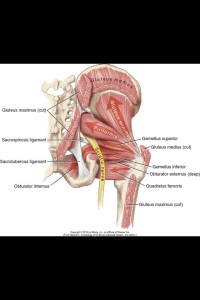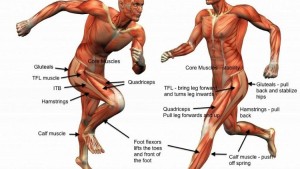JOINT CONTROL: ARTICULAR STRENGTH
Today’s lesson is a brief introduction to osteokinematics and arthrokinematics. You don’t need to memorize them, but all you want tot know is that one is the description of a body part at the site of a joint and synovial fluid (osteokinematics), whereas the second term refers to movement about a joint surface. Lets do a quick example, if you lift up your arm to shoulder height, the action is shoulder extension, and if you take it laterally (away form you) the action becomes horizontal abduction- this is an example of osteokinematics. If we decided to go deeper into the humeral-glenoid fossa (where your arm bone connects inside the shoulder joint) we would begin talking about which part of the joint is open or closed, depending on the arm position. This sort of discussion is based on arthrokinematics.
For today’s blog and video, I am discussing the lateral and medial hip rotators, or femoral rotators. I want to discuss the significance of understanding the mindful and precise control of our femur as it relates to our glutes, hips, and spine health. Certain muscles in the deep glutes will medially rotate the thigh (internal rotation) whereas other hip flexors will laterally rotate the thigh (external rotation). We won’t go into the anatomy of each muscle’s primary, secondary, and tertiary functioning, but you’ll start to understand it as you do the exercise yourself.
KINETIC SEQUENCING: UNDERSTANDING
90/90 hip rotations are a classic feat of strength in the world of movement, restoration, and muscle recruitment. Often pigeonholed as a, “mobility exercise”, I prefer to think of this sort of movement as a strength and control exercise. Lets face it, the exercise world is obsessed with either stationary activities such as biking or rowing, and then you have the rest of the world doing circuit training mixed with running. What these activities have in common is that they work the body, but do they teach you to process and understand which muscles control what actions?
This seemingly simple movement forces you to understand how to control your nervous system, in this case, the muscular and functioning system. If you take a look in the photo below (click on the image to enlarge it) you’ll see the abundant amount of muscles in the back of the hip. In the second photo you’ll see another body labeled with some of the lateral leg muscles. The reason you want to have an idea of this is because unless you’re deliberately moving a joint or extremity in a specific manner, that muscle will not naturally engage or fire. What I mean is, if all you do is run, row, bike, squat, deadlift, and essentially move primarily in the sagittal plane for exercise, than your rotators will not be fed. What do you mean ‘fed’? I mean used, utilized, talked to, recruited for oxygen absorption and function. If you aren’t using your medial or lateral rotators, chances are they’re getting locked short or long (depending on the person and body), which leads to dormancy, inhibition, and numbness. The classic saying, “if you don’t use it, you lose it” strongly applies to these muscle groups.
If you’re somebody who does experience lack of hip mobility or overall spine motility, this movement will absolutely help address that. Remember- static stretching is useful post exercise when a muscle has fatigued and shortened. Dynamic movement proves to be more effective when it comes to creating heat and circulation throughout the body part that is going to be used. Remember, in order to create a stretch on a muscle fiber and create space on a joint surface, one has to work/utilize the desired muscle both at origin and insertion. This is the only way (apart form manual therapy) that a muscle belly will increase in length allowing the joint to increase in range of motion and give you more space somewhere else in the body. It’s time we start thinking about how to create tension throughout the human organism to elicit movement with a deeper sense of control elsewhere in the body. Take a look at these examples of the fascial continuums we all have- with proper potentiation of the muscle chains you can create tension and therefor complex movements!
Start working these muscle chains by taking the time to do the work and create the movement with precision and control. Keep your entire body well fed and watch your abilities grow.



